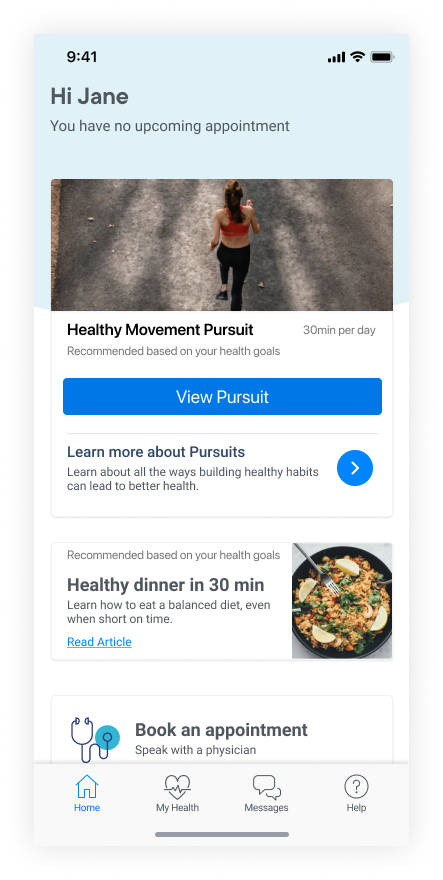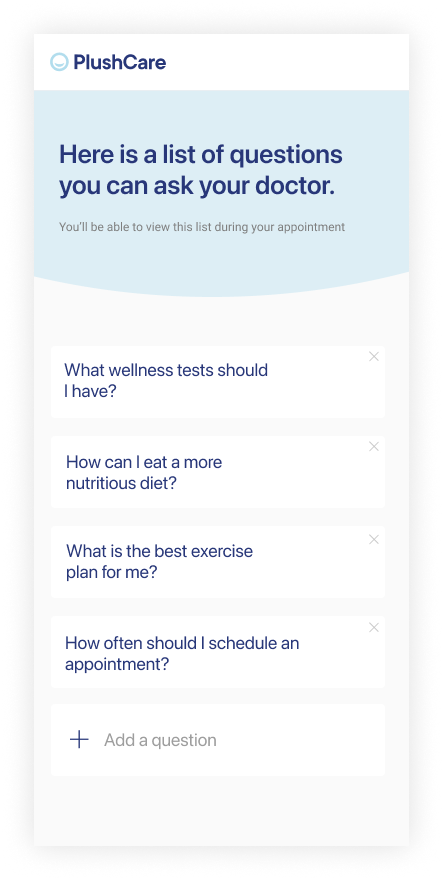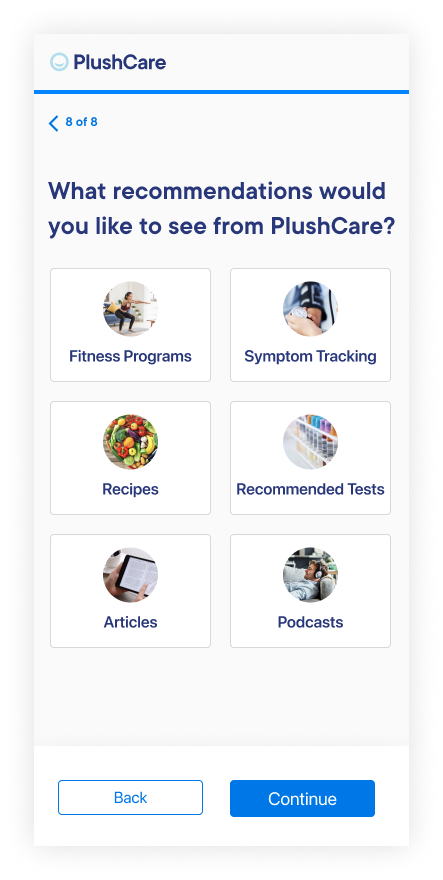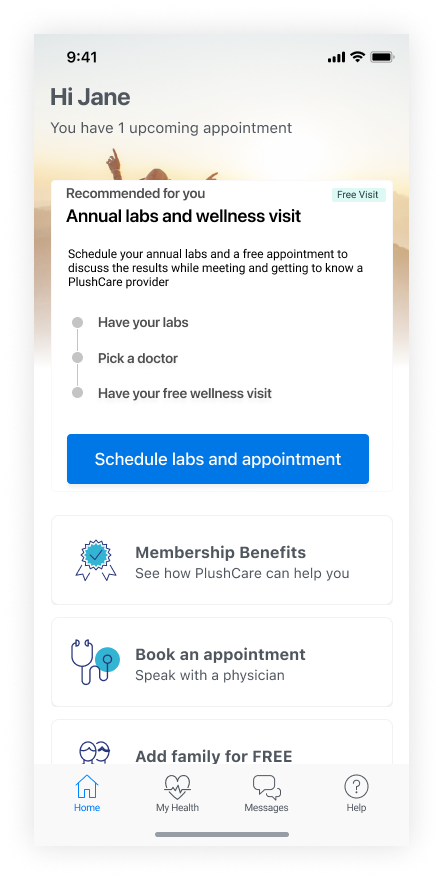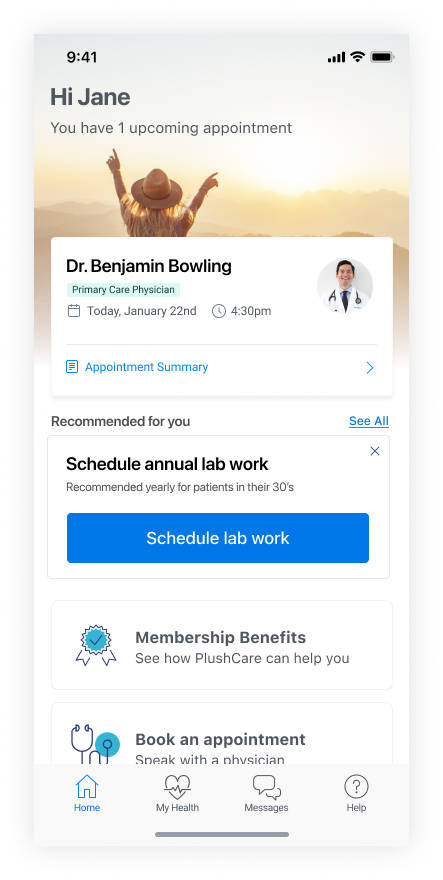
Plushcare is a virtual primary care provider. While I worked there I led design for the patient experience team, and led the creation of their first design system. I I joined Plushcare as a series B startup and stayed with them while they went through an acquisition to Accolade
Project Background and problem definition
PlushCare’s onboarding process was in crisis. They acquired users with a pressing need for medical care, usually medication. The onboarding process was efficient at getting users to sign up, with the average time to see a doctor being 15 minutes. However, PlushCare is a membership based product and the churn rate from one month (after 30 day trial) to three months was alarmingly high. The goal of this project was to address the serious issue with churn by uncovering what an activated user was, and improve the experience over the first 30 days to increase activation over 6 months and beyond.
What we did
In collaboration with my Product Management partner, we defined the scope of the project, worked with the data team to understand the features users who stayed with us longer than 6 months used, and conducted a workshop with stakeholders to define activation.
I conducted primary research with PlushCare users, and completed an audit of the experience of a PlushCare user in the first 30 days.
I defined an ideal continuous onboarding experience that moved users towards activation and outlined this in a journey map. As part of this, I proposed 4 new features which would move move the user towards and activated state.
Outcome and Impact
After the completion of this project we saw a 3% bump in activated users (users who met activation criteria within 30 day trial and continued membership for at least 6 months) This equated to +10,000 users staying with PlushCare for a minimum of 3 additional months leading to at least $450,000 additional revenue quarterly.*
The streamlined onboarding process reduced the number of communications a user might receive from PlushCare in the first 24 hours from 12 down to 3. The reduction in noise meant more room for important messages to reach users.
Three of four concepts proposed were developed to at least MVP
- The member benefits page was developed at an MVP level and showed a promising impact in reducing churn when showed to users as part of a cancel membership flow
- Our concept for an in app post visit experience was instead developed as a consolidated post visit email that encapsulated several emails that a user would receive both before and after an appointment
- Treatment programs was spun off into the next phase of work for me, and is outlined at the end of this case study.
*For the purpose of this case study some impact numbers have been generalized to protect the financials of the client.

The root of the problem
The in app signup process was the extent of the onboarding process, and consisted of a sign up flow, where a user booked an appointment, and ended with the user seeing a doctor in a virtual visit. Along the way they received various communications through several touch points. For some users, this was up to 12. At this point a user was considered onboarded.

Understanding the users

Users generally fell into three categories. Users with acute needs, come to us for a single resolvable issue (most common was UTI) and are more likely to churn because they don’t see the value after their issue is resolved. Ongoing care patients are seeking treatment for chronic issues, and may need frequent visits or medication refills. Standalone members, are ones that have PlushCare as a work benefit and may be aware of if, but have not had an appointment.
Defining Activiation
Working with the data team, we identified things that users who have stayed with us long term are likley to have done. We conducted a workshop to refine this list down to 5 key actions and defined that a users is considered activated if they have completed 4 out of the 5 items.
The activation actions were:
- Signed up
- Seen a doctor
- Gotten a prescription
- Picked a primary care doctor
- Had a follow up visit
Continuous onboarding to maximize activation

I re-imagined the onboarding experience to move away from a single sign up experience, to being a 30 day, continuous onboarding journey. In this 30 day journey, depending on the user type, we can offer different communications and experience to tailor how they might see value in continuing to use PlushCare.
As part of this journey, I proposed 4 new experience concepts.
New experience concepts

I proposed four new experience concepts. Three of four concepts proposed were developed to at least MVP
- The member benefits page was developed at an MVP level and showed a promising impact in reducing churn when showed to users as part of a cancel membership flow
- Our concept for an in app post visit experience was instead developed as a consolidated post visit email that encapsulated several emails that a user would receive both before and after an appointment
- Treatment programs was spun off into the next phase of work for me, and is outlined at the end of this case study.
Shifting clinical strategy
The research we conducted during the onboarding project, made it clear that our issue with activation lay less on the sign up process, and more on how users viewed PlushCare. Most treated us more as an urgent care facility, and less as a primary care facility. To combat this, we worked with the clinical team to identify programs for ongoing care, starting with chronic conditions like Hypertension and Diabetes, and later growing into more wellness focused programs.

